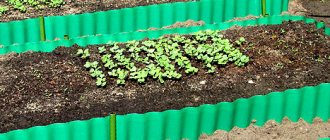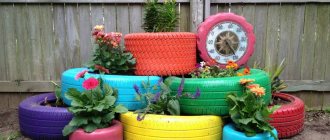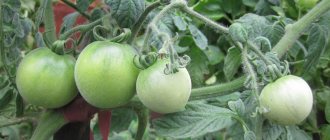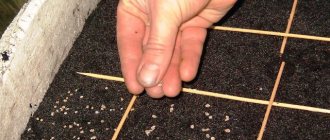Preparing the soil for tomatoes
To get a decent harvest even before planting tomatoes in open ground, you should choose the optimal place for tomato bushes. The culture loves indirect sunlight, and usually performs well in illuminated but sheltered beds. The best pre-tomato plants are onions, carrots and cucumbers. If you plant seedlings next to strawberries, both crops will show a good reaction. The yield of both plants will increase noticeably, and the ripened fruits will grow more voluminous. The beds where eggplants, peppers, and potatoes were previously planted should not be given over to tomatoes, since in these areas there is a high probability of finding pathogens of various diseases.
The quality of soil varies not only in each region, but even in the fields of the same area. Tomato crops are quite picky about soil, which is why, before planting tomatoes in open ground, it is best to find out, if possible, the condition of the soil in future beds for tomato seedlings. Garden departments sell tests that determine soil acidity. The lower the indicator, the higher the acidity level is considered. A soil with a number of 7.0 is considered neutral. Tomatoes will grow well with an acidity range of 6 to 7. If the number is lower, it is worth adding lime to the soil, if higher, sulfur.
Compost is an ideal tool for preparing land for planting. It also acts as a good bait for earthworms, which are known to perfectly loosen the soil and provide a favorable environment for beneficial bacteria. Experienced gardeners know how to plant tomatoes correctly, and begin preparing the soil in the fall immediately after thoroughly clearing the area of previous plants and their remains. It is better not to use manure, since tomatoes, after fertilizing with manure, begin to actively grow leaves to the detriment of the fruits. If the soil does not warm up well, it is usually covered with black film or dark plastic.
Time to plant tomatoes in beds
The most common period when you can plant tomatoes in open ground is certainly May. Usually during this month, hardened tomato seedlings are transplanted into open beds. During the warm spring, some gardeners try to plant bushes a little earlier, hoping for a quick harvest. However, there is no need to rush; tomatoes planted in mid-April may take a long time to take root, get sick and even die, since the soil has not yet warmed up enough.
In the first ten days of May, the first planting of seedlings, which have already become a little stronger in the air and sun, gradually begins. The best time to plant tomatoes in open ground is in the afternoon or evening. At this moment, the sun is no longer shining so brightly, or you should choose cloudy weather for transplanting to the beds. Thus, the entire process of planting young plants may not occur in one go.
Formation and location of beds
Gardeners have long formed the opinion that the tomato planting pattern affects the future number of fruits. The most common arrangement of beds: traditional and double rows. According to the traditional method, rows of beds about a meter wide or a little more in the direction from north to south are formed on the prepared soil, about 5 days before planting. This rule helps ensure uniform illumination of the sprouts. There is usually a distance of 70 centimeters between the beds, regardless of the tomato variety.
Young bushes are placed in two rows. As for the space at what distance to plant tomatoes, for low varieties the gap is approximately 30 centimeters, for medium and tall varieties - 45 cm. When forming double ridges, tomato bushes are placed in a checkerboard pattern on a strip of soil about half a meter wide, leaving wide paths between them beds. Wide paths are comfortable, it is convenient to pull hoses along them, to process bushes; with such planting, each sprout receives more light.
Preparing the soil for tomatoes
Tomatoes grow well after onions, carrots, cucumbers, and they are favorably influenced by proximity to strawberries. You cannot plant after eggplants, peppers, potatoes, because they have the same diseases and the pathogens remain in the ground.
Soil quality is not the most important thing for tomatoes. They grow well in loamy and sandy soils. If the soil is clayey or heavy, sand, sawdust, peat and humus or compost are added to it. For 1 sq. m up to 3 buckets of sand and up to 4 buckets of humus.
Important! Do not introduce fresh manure or bird droppings. Excessive amounts of them can burn plant roots.
Too light sandy soil is improved with organic matter - rotted manure or compost.
Preparing the bed
Tomatoes do not grow well in acidic soils. If sorrel and buttercups grow freely on the site, it means the soil is acidic. Reduce acidity by adding ash (every two years, 2 cups per square meter) and limestone (every 4 years, 200 g per square meter).
Advice! To prevent fungal diseases, the soil can be treated with any antifungal drug.
At the end of September - beginning of October, depending on the weather, the soil is dug up to a depth of 25 cm; large clods of earth are not crushed, but are left to retain snow. Now the tomato plot is prepared for wintering. In the spring you will need to loosen and disinfect the soil. If the soil is light, sandy, from which rain and melt water washes away all nutrients, mineral fertilizers are added in the spring.
Grown seedlings are planted in open ground at the beginning or end of May, depending on the climatic conditions of the region.
Types and sizes of beds for tomatoes
The size of tomato plots is directly influenced by what varieties the gardener plans to grow and the method of plant formation.
When choosing powerful, tall, indeterminate varieties (especially if you plan to form two stems), the distance between plants in the row and between the rows should be greater than when growing low-growing, compact tomatoes.
The planting scheme directly affects the size, namely the width of the plots. The length is limited by the size of the plot and the number of tomatoes that are planned to be planted:
Wide beds. This option is suitable for growing tall and powerful tomatoes. The width of such plots is 1.1-1.2 m. When planting in two lines, the row spacing is on average 70-80 cm, and the distance between tomatoes in a row is 40-50 cm. The passage between the plots should be wide so that there are no difficulties when harvesting and performing other agricultural work. Medium-sized varieties can also be planted on them, in which case the row spacing will be 60 cm, and the distance between tomatoes in a row will be 30-40 cm. The width of the planting plot is also reduced - it will be 0.9-1.1 m.
Narrow beds. They are made for planting compact, low-growing varieties. The row spacing is 40-50 cm, between plants in a row is 30-40 cm. The width of the passage between plots is 70-80 cm. Both wide and narrow beds are suitable for two-line planting. When planting tomatoes in one line, the width of the plot will be on average 50 cm; this option of planting seedlings is less profitable and productive.
High beds. They can also be either wide or narrow. Their difference is that tomatoes are planted not at soil level, but at some elevation above it. The height of the ridge should be convenient for caring for and harvesting the nightshade crop. Basically, gardeners pour them 25-30 centimeters high, but preferably no higher than 40 cm.
Box beds. This is a type of raised beds, but they are distinguished by their convenience, ease of care, excellent appearance, durability, and functionality. Such plots produce an earlier, richer harvest. You can make beds from various materials, but the most common is wooden boards. Moreover, they even choose substandard wood, the main thing is that it is not rotten or eaten by pests. Before installing the structure, the boards are treated with a protective antiseptic. It is best to use hardwood - oak, acacia and others. The width of the bed for tomatoes in open ground depends on which varieties will be planted and according to what scheme. Typically, such plots are formed in the form of a rectangle. After assembling the structure, a drainage layer is poured or agrofibre is laid over it, and a mixture of garden soil with non-acidic, nutritious peat, rotted manure and universal granular fertilizers is poured onto it. Afterwards, water well and tomato seedlings are planted.
Warm beds. This interesting way of preparing a planting plot allows tomatoes to start the growing season faster. Consequently, gardeners will be able to harvest from such plants much earlier. This is achieved due to the fact that the beds are heated not only by the sun’s rays from above, but also by heat from below. It is released as a result of rotting, decomposition of organic matter embedded in the “foundation”.
Examples of beautiful beds for tomatoes
Do-it-yourself tomato beds in the open ground can become a decoration for your site. Looks great as:
- spirals;
- circle;
- triangle;
- U or M-shaped;
- in the form of waves, figures, flowers.
Marigolds or nasturtiums are planted around the perimeter. The flowers serve as decoration for the greenhouse and at the same time repel pests.
Flowers in vertical beds look interesting along with cherry tomatoes hung with vines with fruits. You can grow flower and tomato varieties in hanging containers and pyramids. For registration it is recommended to use:
- fence,
- wattle fence,
- tiles
Figures of gnomes and animals look attractive on such beds. Small lamps for installation on the ground are popular.
Problems when growing ground tomatoes
Late blight affects ground tomatoes very early, especially when adjacent to potatoes. To prevent disease, the distance between crops should be at least 200 m. But in a small area this is almost impossible to do.
The only preventive measure is spraying both crops with copper preparations (HOM, Oxychom, Ordan). Copper-containing preparations are alternated with Previkur or Consento. Treatments are carried out at intervals of 10-12 days throughout the entire growing season, alternating chemicals. Solutions of these drugs are spilled on the soil under the tomatoes.
Phytophthora later appears where copper is present, so tomato stems are wrapped with copper wire. Wire can also be inserted between potato hogs.
But, despite all the measures, late blight will still appear in the open ground. The only question is timing. The later the disease appears, the greater the harvest you can get.
Cladosporiosis severely affects soil-grown tomatoes in the south. In the middle zone in open ground, the disease is rare. Since the disease begins with the lower leaves, their timely removal reduces the risk of the disease. For prevention, treating bushes with Pseudobacterin is a good option. Treatments are carried out 3-5 times per season with an interval of 7-10 days.
When the first signs of the disease appear, the affected leaves are removed and the tomatoes are treated with copper-containing preparations.
In the middle zone, it is much more difficult to get a good harvest of ground tomatoes than with greenhouse cultivation. Often the efforts are not worth it. Therefore, greenhouse cultivation is preferable here. In the south, on the contrary, it is better to grow tomatoes in open ground, covering them with spunbond on cold days. With the right selection of varieties and proper care, two harvests are harvested here per season.
- Schemes for feeding tomatoes in a greenhouse and exhaust gas
- Growing tomatoes Bull's heart
- The most dangerous tomato diseases and methods of treating them
- What to do if tomato leaves curl
- How to pick tomatoes correctly and why to do it
- Rules for planting tomato seedlings in a greenhouse
- Caring for tomatoes in a greenhouse
- How to protect tomatoes from late blight
Preparing beds and soil
You need to start preparing for planting tomatoes in advance; most often this is done in the fall, so that everything is ready by spring. Tomatoes are very sun-loving, so they are given an open, sunny place in the garden. This crop cannot be planted even in weak shade or under trees; bright light and sun are required all day long. In low light, tomatoes will grow poorly, will not ripen, will spoil, and even if they reach perfect condition, their taste will leave much to be desired. Only tomatoes grown in the sun, with proper agricultural technology, turn out juicy and, as they say, sugary.
In the fall, they begin to prepare future beds for tomatoes. The quality of the soil is of great importance; tomatoes need it to be nutritious, so various fertilizers are added to the soil. The soil is thoroughly dug up, weeds and roots are removed, and loosened. Add manure or compost at about 5 kg per 1 m2 - these fertilizers can only be applied in the fall, then they will rot over the winter and enrich the soil with useful substances. They cannot be used in the spring.
In addition to manure and compost or in addition to them, you can add 40-50 g of potassium chloride and superphosphate per square meter. These fertilizers must be mixed with the soil and not scattered over the surface.
But not always and not everyone succeeds in preparing the soil for tomatoes in the fall. In the spring, you can also work on the soil: to grow tomatoes, add 20 g of saltpeter, 60 g of nitrophoska, 1.5 cups of wood ash powder and a bucket of compost per 1 m2. Fertilizers must be thoroughly mixed with the soil; compost can be additionally added to the holes.
The following rule applies to fertilizers: it’s better to use too little than too much. If you overdo it with fertilizers, the tomatoes will actively sap, which will negatively affect the development of the bush and the harvest.
Tomatoes often suffer from various types of fungi, this applies to both seedlings and adult bushes. The seedlings die from blackleg and other similar aggressive fungi; other diseases, various rots, molds, but no less dangerous, live in the open ground. Experienced vegetable growers recommend disinfecting the soil before planting tomatoes; using copper sulfate or copper oxychloride to treat the soil against fungi.
The beds and holes for tomatoes are made a few days before planting the seedlings. This cannot be done day after day, because in this case the soil will be cold. Sometimes fertilizers are added directly to the holes, then they are poured with plenty of water and left for a day so that the earth warms up. The distance between the holes is 35-50 cm, depending on the variety; the distance between the rows is larger - 50-70 cm.
Terms and rules for preparing beds for tomatoes
In the spring, the arrangement of the ridge begins a month before the seedlings are planted in it. Last year's leaf litter, hay, and compost are used for thermal insulation. The photo shows beds for tomatoes in open ground:
Open ridges are buried 20 cm and filled with peat to increase soil fertility
In the fall, after harvesting, the beds are cleared of tops and green manure is sown. In the southern regions, in October-November before the onset of frost, they dig up before winter, leaving a large lump of soil. In northern latitudes, digging begins in September.
Preparing beds for tomatoes in spring
To prepare a bed for tomatoes in the spring, it is enough to level the ridges dug up in the fall with a rake. Then add nitrogen fertilizers (1 tbsp per 1 m2) and disinfect with antifungal drugs. Next, add ash, lime, and dolomite flour.
Mineral fertilizers can replace organic matter. Such as:
- humus;
- leaf litter;
- vegetable waste after cooking;
- peat;
- rotted manure or bird droppings.
Attention! Organic substances are spread on the soil in a layer of 10-20 cm. Allow to settle and dig to a depth of 20 cm.
Before planting, the ridge plants are loosened with a flat cutter or rake. Spring preparation of the ridge plants in the greenhouse begins in February-March, before the snow melts
Preparing a bed for tomatoes in the fall
The preparation of beds in the fall for tomatoes is carried out in place of the beds with:
- cucumbers;
- zucchini;
- carrots;
- Luke;
- beets;
- pumpkins.
The site for the ridge is dug up in October to a depth of 20-25 cm, leaving a large lump of earth.
Large digging is needed to retain snow in winter
Sprinkle 2 cups of ash per 1 m2 on top of the dug up soil. Phosphorus and potassium fertilizers are applied 1-2 tbsp. l. per 1 m2.
Using simple garden soil: how to prepare and process?
After a place for tomatoes has been chosen, it is necessary to prepare the area for planting. It is recommended to cultivate the soil twice a year:
- In the fall, the ground is dug up to destroy weeds. Poor soil should be fertilized with organic fertilizers (humus at the rate of 5 kg per 1 sq.m.). You can also add mineral fertilizers (50 g of superphosphate or 25 g of potassium salt per 1 square meter).
- In the spring, the area is cultivated to prepare the land for planting. Bird droppings are used as fertilizers at the rate of 1 kg per 1 sq.m., wood ash in the same proportion and ammonium sulfate (25 g are used per 1 sq.m.). It is necessary to apply fertilizers at least 4 weeks before planting in order to so that minerals are evenly distributed in the soil.
- Increased soil acidity is corrected by adding lime in an amount of 500-800 g per square meter of area.
Experienced gardeners do not recommend using fresh manure for tomatoes, since in this case the plants will build up green mass to the detriment of the formation of ovaries.
The beds for tomatoes begin to be prepared at the end of May:
- Small trenches are formed in a north-south direction. The distance between rows is 70 cm, between beds from 1 meter.
- For each bed you need to make sides about 5 cm high. This system prevents water from spreading during watering.
- Now you can plant tomato seedlings in open ground.
To grow tomatoes, it is important to know how to choose soil for seedlings, including ready-made soil for tomatoes and peppers. And if you want to grow them in a greenhouse, then read this article, which talks about what kind of soil is needed for this.. Tomatoes are everyone’s favorite vegetable on summer and winter tables
Although it is demanding in care, if you approach the issue of growing tomatoes with knowledge of the subject and with love for the land, you will be pleased with the harvest!
Tomatoes are everyone’s favorite vegetable on summer and winter tables. Although it is demanding in care, if you approach the issue of growing tomatoes with knowledge of the subject and with love for the land, you will be pleased with the harvest!
Sowing seeds in open ground
The planned planting of tomato seeds directly into the ground has its own subtleties. As you know, tomatoes are susceptible to the same diseases and pests as peppers, potatoes and eggplants, so when sowing seeds it is better to avoid places where these crops previously grew, because disease carriers in the soil can remain active for several years. The most favorable predecessors of tomatoes are legumes, pumpkins, cabbage, and zucchini.
Preparing seeds for planting
One of the main things in how to properly plant tomatoes in open ground directly with seeds is preparing the soil.
In the spring, after the soil has dried, the soil should be well loosened and leveled to retain moisture and get rid of weeds. For sowing, it is better to choose a plot of the garden protected from the wind. Sowing is usually done in mid-April. The seeds are evenly distributed in holes with a diameter of 40 centimeters. Each hole is watered with water and potassium permanganate. Quite often, before sowing tomatoes in open ground, gardeners fear that during frost or cold weather the seedlings may die and the beds will have to be reseeded. To minimize this, experienced gardeners often sow sprouted seeds along with dry ones. Sprouts from dry grains will germinate later, but will be able to avoid cold weather. Many garden lovers believe that bushes grown from seeds are stronger and less sensitive to diseases than tomatoes planted from seedlings.
Thinning tomato shoots
When 2-3 leaves appear on the emerging sprouts, the shoots should be thinned out.
The optimal distance between bushes should be 5-10 centimeters. Before sowing tomatoes in open ground, gardeners know that not all sprouts that hatch should be left, but only the strongest ones. The second thinning is done after 4-5 leaves have grown, again leaving only strong bushes at a distance of 15 centimeters. After the final thinning, the gap between shoots is about 40 cm. It is worth saying that planting tomatoes in the ground is stressful for young seedlings. For this reason, some sprouts begin to wither. Most often these are those bushes that did not have enough sunlight. And there is nothing unusual about this. After about two weeks, weakened sprouts will recover with proper care. Caring for tomatoes in open beds involves constantly maintaining the soil without weeds. Tomato fruits pour quite slowly, which means that a small amount of moisture is needed. But if the soil is too dry, the green fruits may rot.
Selecting a site, preparing soil and beds for planting tomatoes
So, based on the above, you were able to choose a suitable site. Next comes preparing the soil for future beds. It is best to prepare the soil in the fall, namely, dig up the soil, adding wood ash and humus to it. To improve the nutritional value of the soil, you can sow the area with oats for the winter. In the spring it will be much easier to dig it up a second time, remove the weeds and add fertilizer.
When the soil is ready, you need to form the beds. The following types of tomato beds are distinguished:
1. Warm beds in open ground. Tomatoes are very heat-loving plants, so many summer residents choose this type of garden bed. They work on the principle of a compost heap: organic matter rots and gives off its heat.
Such a bed is made as follows: a trench is dug a meter wide and half a meter deep, and wood chips, sawdust, dry grass, and shrubs are placed at its bottom. A layer of organic matter is placed on a layer of wood, on top of which manure is poured. Next, they begin to complete the top layer, consisting of last year's compost and soil. Tomatoes are planted in such beds a little earlier, as is harvesting.
High bed for tomatoes
2. High bed. This type of arrangement is very similar to a warm garden bed. A high bed is soil raised above the main level of the garden and framed with special sides. Tomatoes in such soil are easy to care for, since the appearance of weeds is hampered by the sides. Such beds are not destroyed during the winter and during unfavorable weather conditions.
3. Regular garden bed. Many gardeners are negligent in preparing their beds and make the usual dug beds. Unfortunately, they have many disadvantages: a large number of weeds, it is impossible to protect them from frost, wide beds complicate the care of plants. Therefore, such beds are more suitable for greenhouses.
How to form a tomato bed
The gardener decides which plot to form himself, depending on climatic conditions and other factors. An earlier, more abundant harvest is obtained by growing tomatoes in high or warm beds.
High bed
Before creating a new plot, gardeners determine the future size. Afterwards, pegs are driven in around the perimeter of the future tomato bed and a guideline - a rope - is pulled. Then, alternately, on each side, throw up the soil with a shovel to the desired height, and then level it, lightly compacting it. At the final stage, the sides of the formed beds are cleared of soil at an angle of 90 or 45 degrees.
Warm bed
First you need to form a box from strong wooden boards. It is advisable to treat them with biological preservatives, which will prevent premature damage to the wood. The width is again determined by the gardener himself, depending on what varieties of tomatoes will be planted. But the height must be at least 50 cm.
Particular attention should be paid to strengthening the boards at the corners, since the structure may collapse under the heavy weight of the earth. To be on the safe side, the constructed structures are strengthened along the entire perimeter, additionally increasing the ribs - wooden blocks, thick reinforcement or pipes are dug into the ground
Warm planting plots begin to be prepared on average a month before planting tomato seedlings.
First of all, a thermal barrier in the form of an ordinary greenhouse film is spread at the bottom. It will protect the plot’s soil from the cold coming from the frozen ground. Afterwards, a layer consisting of chopped branches, leaves, and remains of other plants is poured onto it.
Then a second layer is poured onto the first layer, which includes fresh compost and manure. The last one is filled with ordinary garden soil, to which all the necessary fertilizers are added. Afterwards it is well poured with warm water and covered with film. As a result, a greenhouse effect is created: organic matter “ignites”, rotting processes begin, and, consequently, the release of heat. After about a month, the top protective layer - the film - is removed, starting to plant tomato seedlings.
The temperature inside such a plot is 7-10 degrees higher than in spring garden soil. This promotes faster development of tomatoes
It is important to remember that the operation of a warm bed has its own characteristics
First of all, this means watering only with warm water, as well as special attention to the fight against soil pests. Warm, rotting organic environments are their favorite habitat.
Therefore, it is necessary to spray the soil with insecticides such as Antikhrushch, Nurell D, Aktara.
What to make a warm bed from
A high warm bed can be made from a wide variety of materials that are available: board, slate, plastic, metal, stone, brick. If not only functionality and benefits are important to you, but also beauty, then you will have to try a little more. However, such a garden will be pleasing to the eye and will become part of the overall landscape.
High beds arranged using gabions are ready-made composters. All season you put plant residues in them, and in the fall you fill them with soil - the bed is ready for the next season.
The beds with herbs look picturesque and give off aromas. Such flower beds especially need watering.
From several beds you can create a composition in the form of a flower, pattern, or geometric shapes. This creative approach will decorate your site and make it more interesting. Use garden figurines, vases, birdbaths, and scarecrows as decorations.
Decorative borders are another way to turn an ordinary garden bed into an original landscape feature. Depending on the style of the garden, the border can be made in the form of a fence for a rustic style, decorated with mosaics for a Mediterranean style, or the stone will remind you of Italy.
A warm bed can even fit in a barrel! For example, from such a small area, you can get a pretty decent harvest.
Caring for such beds is as simple as possible, and the beds themselves become the highlight of the garden and give it volume.
decorateme.com
Peat soil
This is difficult soil. There are massifs where the peat has completely decomposed to a dusty state. The not completely decomposed top layer of swamps consists of coarse-fibered plant remains.
Peat soil
Peat is a low-nutrient soil and is often used as an inert component. Lowland peat, as a rule, has a slightly acidic, sometimes almost neutral reaction. High-moor peat of varying degrees of decomposition has an acidic reaction. When improving peat lands for growing vegetables, it is necessary to add nutrient soils (turf, leaf, garden loam or clay), sand and organic matter (humus, compost, vermicompost).
Most vegetable crops can only grow safely on slightly acidic (pH 5.5) or neutral (pH = 7.0) soils, so acidic peat requires deacidification. To do this, use chalk, slaked lime, dolomite flour or other components containing lime. The deoxidation process takes quite a long time, so it is better to carry out this work six months before using the site. The following video takes a closer look at the features and differences between lowland and highland peat.
The variety of soils is great, as are the components that can be added to them to improve their properties. Despite this, when growing seedlings and at permanent plant development sites, we use standard substrates that do not contain peat at all or with a small amount of it. Sometimes we supplement the composition of the substrates using standard deoxidized peat, clean river sand, perlite, and vermiculite. In such soils, not only green, pumpkin, and bulbous crops grow and bear fruit well, but tomatoes also produce huge yields.
If you cannot collect about 5 kg of ripe fruits from one plant, then you probably do not listen to our advice. Try to grow tomatoes such as 'Lyubasha F1', 'Lyric F1', 'Treasure of the Incas F1', 'Royal Temptation F1', 'Raspberry Empire F1', 'Cherry Vera F1', 'Cherry Lyuba F1', 'Kotya F1' , 'Dream F1', 'Last name F1', 'Brown bunch F1', 'Duchess of taste F1'. Any of these hybrids, presented in the agro tomato assortment, will delight you with its productivity, beauty and taste. These tomatoes are very resistant to major diseases and patiently tolerate difficult weather conditions in central Russia.
Tomatoes 'Raspberry Empire F1'
Feeding tomatoes
The first time fertilizer is applied 2-3 weeks after planting the seedlings in the ground. Weakened plants can be fed a week earlier.
In this case, nettle infusion is used. It is prepared as follows: nettles without roots are placed in a barrel up to half the volume, filled with water and covered with film. After 7-10 days the fertilizer is ready for use.
The resulting infusion is poured into a bucket, 1 tbsp is added there. l. Kemira, stir well and water the tomatoes at the root so that the splashes do not get on the leaves. Consumption of nettle infusion is 1.5-2 liters per 10 plants.
The second and third feeding is carried out during flowering and fruit growth. The same fertilizer is used, but the dose of Kemira is doubled.
Foliar feeding is also useful. To stimulate the appearance of ovaries during the flowering period, once every 10 days, tomatoes are sprayed with boric acid (10 g diluted in 10 liters of hot water, the solution is cooled before use).
To speed up the ripening of fruits, immediately after planting the seedlings and during the formation of buds, spray the plants with Ovary or Tomaton. But keep in mind that it is not recommended to use stimulants more than twice a season.
Benefits of a raised bed
Summer residents from the northern regions constantly face difficulties in growing heat-loving crops. In short summer conditions, it is almost impossible to get a good tomato harvest. Spring is long, the ground takes a long time to warm up, and recurrent frosts are often observed in early summer. It is possible to plant seedlings in open ground only closer to mid-June; tomatoes do not have time to ripen before the first autumn cold, which arrives here at the end of September.
Attention!
Growing tomatoes in boxes is important for areas where the soil remains cold for a long time. In regions with early, warm springs and hot summers, the roots in the box will burn; planting in recesses is popular here.
To install a large greenhouse you need a lot of money and a sufficient amount of free space on the site. It is even more difficult for those who have a vegetable garden located on a slope; it is impossible to place a greenhouse in such conditions. Box beds (soil raised above the main level of the garden, framed by high sides) allow you to solve several problems at once:
- the soil warms up faster, tomatoes can be planted earlier;
- It is easy to install pegs or arcs on the structure and cover them with polyethylene (to protect plants during cold periods);
- boxes allow rational use of free space in a small area, since they do not take up much space;
- installation is possible both on flat and flat areas. On the slope, the boxes should be placed in the form of terraces. When arranging, you should take care of the paths and level the upper sides strictly horizontally;
- It is easier to care for plants and it is convenient to approach them;
- the soil always remains inside the structure and is not washed away during watering, during rains or after snow melts;
- Tomato roots do not like stagnant moisture, so they are not planted in places with high groundwater levels. In a high bed, water does not stagnate, it can be installed in a problem area, and crops can be grown without the risk of rotting;
- the box is easy to install and dismantle; the structures can be permanent or portable.
Let us also note the aesthetic side of such structures. The tall mini-garden is a geometrically regular figure that looks very attractive on the site. Even an inexperienced summer resident can make a box bed with his own hands, based on his own wishes and capabilities; there are no complicated plans or strict calculations. There are 2 options for tall structures:
- Narrow (for planting tomatoes in 1 row) - width no more than 50 cm. It is possible to cover the bushes using a tent method, install supports in the middle of each edge of the box, connect them at the top with a crossbar on which to throw the canvas.
- Wide (for planting tomatoes in 2 rows) – width up to 120 cm. You can install arcs for shelter, the canvas will be easy to lift on each side of the box.
Both options are good in their own way, it is difficult to clearly determine which will be more successful, it all depends on the goals and free space on the site. One thing is for sure, boxes are better and more convenient than classic beds. After rains and waterings, you don’t have to walk through the mud. Paths can be overgrown with weeds, but they do not penetrate into the beds from behind the sides, and weeds that have sprouted inside the structure can be easily removed without weeding.
Dates for planting tomatoes in the middle zone
In the middle zone, it is recommended to plant grown tomato bushes in early April in greenhouses and greenhouses and in mid-May in open beds; choose the best day according to the lunar calendar. Seedlings planted in the garden before May 15 may be subject to night frosts, for which the first days of May are famous (usually they coincide with the flowering period of apricots).
If you nevertheless decide to plant early, and weather forecasters predict a sharp drop in temperature, then cover the plantings with film at night, fixing it along the contour of the beds with cobblestones or bricks. Such insulation usually helps plants to withstand sudden cold snaps normally.
General information
The tomato, intended for growing in a greenhouse, belongs to the Solanaceae genus and is a herbaceous plant. The root system is rod-shaped and quite well developed. The leaves of the tomato are odd-pinnate, sometimes strongly reminiscent of potatoes. The stem is erect or branched.
Tomatoes for growing in a greenhouse, depending on the variety, are also divided into types. Even experienced gardeners are confused by this classification. Stand out:
- Peruvian tomatoes;
- hairy tomatoes;
- ordinary tomatoes.
In order to choose the right variety for a greenhouse or greenhouse, you must know the basic characteristics of the plant:
- bush height;
- determinant or indeterminate type;
- timing of fruit ripening;
- versatility of using the harvested crop.
In addition, tomatoes can be intended for a summer or winter greenhouse. The quality and quantity of the future harvest depends on how correctly the variety is selected for specific conditions and requirements.
The best soil for tomatoes: how to make the beds fertile
Our country has a very vast territory, and naturally the soils are very different. Nevertheless, beds and gardens thrive even in the most difficult climatic conditions, delighting with their fruits and enchanting with ornamental plants.
The beds delight with their fruits
How is it that plants that have certain growing requirements grow well in completely different conditions? The answer is simple. To smooth out, level the environment, and adapt plants to a specific area, first of all, various types of shelters and, no less important, the soil, which is necessary in structure, nutritional value and acidity, help.
Any soil can be adapted for growing nightshade crops. For example, tomatoes 'Pride of the feast F1', 'Great F1', 'Cherry paint F1', 'Cherry Kokta F1', 'Cherry Your Nobility F1', 'Imperial weakness F1', 'Raspberry idea F1' will grow remarkably well on adjusted clay, and on weighted sand. Let's consider the most typical, most common types of soil: sandy, sandy loam, clayey, loamy, peat.
Diseases and pests of tomatoes, control methods
There are quite a few pests that can harm tomatoes, the most common of which are:
- The mole cricket is an insect that settles on well-fertilized and moist soils. To combat it, strong insecticidal preparations are used, including infusions of vinegar and red pepper.
- Wireworms are larvae that are covered with a dense shell and damage the root system of the plant. For prevention, during autumn site preparation, acidic soils are alkalized.
- Gnawing cutworms - these caterpillars are considered the most dangerous enemy of vegetable crops. For prevention, it is recommended to carry out deep mechanical tillage and timely weeding. If caterpillars appear in large numbers on tomatoes, they must be collected and destroyed manually.
Mole cricket - a pest of tomatoes
Wireworms: these larvae cause damage to the root system
Gnawing cutworms are dangerous caterpillars
Tomatoes can suffer from the Colorado potato beetle, thrips, spider mites, whiteflies and melon aphids. To combat these types of pests, it is worth using insecticidal preparations.
It is recommended to carry out preventive spraying of tomatoes every 5-7 days, alternately using onion infusion and Bordeaux mixture. If the plant has been affected by a dangerous infection, serious treatment is required.
Tomatoes are often subject to diseases such as blossom end rot, mosaic, late blight, wild spot, anthracnose, fomoz, etc. In this case, it is necessary to treat the plants with special potent fungicides, and the affected parts of the plant must be removed.
If the tomatoes are severely damaged, complete destruction of the planting is required. To minimize the likelihood of re-development of the infection, before the new season the soil must be treated with disinfectants, for example, watered with a solution of copper sulfate, a hot solution of potassium permanganate, and deep digging is performed.
How to make beds for tomatoes with your own hands
Making your own beds is quite easy. If necessary, you can start arranging a high or warm bed for tomatoes in the spring. No difficulties should arise if, in the process of carrying out the work, you follow a step-by-step algorithm, as well as the advice and recommendations of experienced gardeners.
It is important to understand that in order to obtain a high yield, it is important not only to choose the right planting material and carry out the planting process. An equally important point is the preparation of the soil and place for planting tomatoes.
The ease of caring for the plants and the amount of sunlight penetrating each crop depend on how well the site is landscaped. It is worth thinking in advance about how watering will be organized - this will save you from many problems in the future.
How to make raised beds for tomatoes
It is important to correctly determine the optimal height of the beds for tomatoes. In high beds it is quite easy and convenient to carry out the process of cultivating tomatoes
In order to make the sides, you will need to use the following materials:
- asbestos-cement slate sheets;
- building brick;
- boards.
Just as in warm options, in this case it will be necessary to use organic matter, due to which the seedlings will be heated in the spring. You can do planting work several weeks earlier than gardeners usually do. During the process of decay of organic matter, the process of heat release begins. If, during the growth of the crop, you water the tomatoes frequently and abundantly, then the process of decay of organic matter becomes much more intense.
Raised beds consist of several layers. The sequence of layers should be as follows:
- wood – you can use bush branches after sanitary pruning or crown formation;
- hay, weeds, fruit and vegetable peelings;
- compost, manure, chicken droppings;
- wood ash;
- nutritious soil.
Many experienced gardeners note that it is not necessary to use a fence. In this case, you can simply form mounds, on the surface of which tomatoes are subsequently planted.











